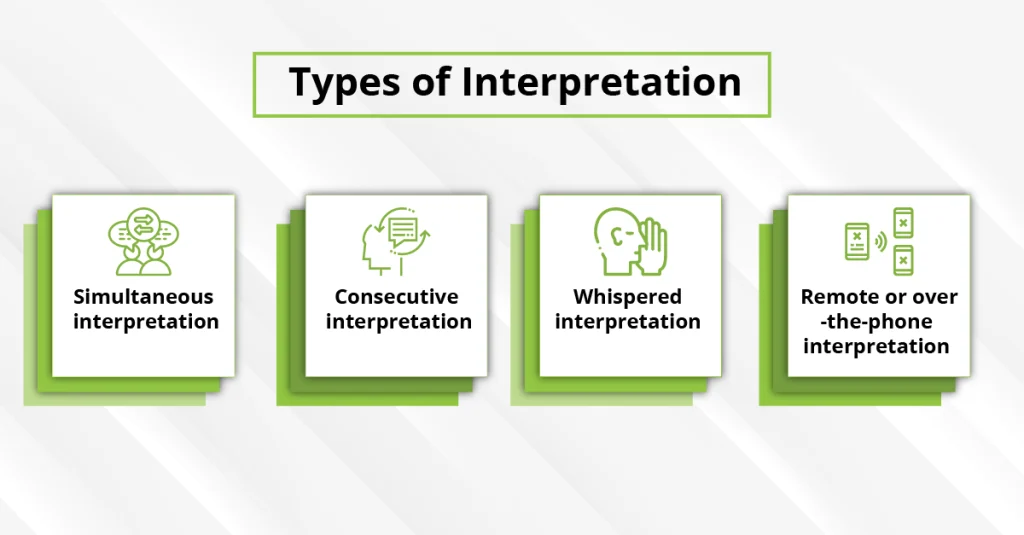Think of ways of breaking language barriers. Most people immediately picture translation—text on a page, website, or screen.
But when the conversation is happening live, whether in person or over a call, it’s language interpretation that steps in to bridge the gap in real time.
Unlike translation, which deals with written content, interpretation is spoken. It’s about conveying meaning in real time, ensuring smooth and accurate conversations between speakers of different languages.
In today’s fast-paced global landscape, professional interpretation is essential.
From United Nations assemblies and global business meetings to international healthcare settings, skilled interpreters work behind the scenes to facilitate critical cross-cultural exchanges.
And while the goal is always the same—clear understanding—different situations call for different types of interpretation.
Understanding these types is key to choosing the right approach for your specific needs. Let’s explore the four main types of interpretation.

Simultaneous Interpretation: Real-Time Multilingual Communication
Definition:
The interpreter listens and translates the message in real time, with only a brief delay.
Where it’s used:
- High-speed settings like international conferences, courtrooms, and United Nations meetings
- Large-scale business events or live broadcasts
Remote Simultaneous Interpretation (RSI):
The interpreter sits in a soundproof booth or remote setup and delivers real-time interpretation using specialized RSI platforms.
Benefits:
- Fast and uninterrupted communication
- Ideal for multilingual audience
Considerations:
- Requires professional training, deep focus, and advanced equipment
- Often involves teams of interpreters rotating to avoid fatigue.
- Consecutive Interpretation: Clarity with Pause and Repeat
Definition:
The interpreter listens to a segment of speech, waits for the speaker to pause, and then translates it into the target language.
Where it’s used:
- Medical consultations
- Legal depositions and interviews
- One-on-one meetings or small group discussions
Benefits:
- Allows interpreters to capture tone, emotion, and intent more accurately
- Ideal for settings where precision is critical
Considerations:
- Takes more time than simultaneous interpretation
- Requires strong memory and note-taking skills from the interpreter
Whispered and Liaison Interpretation: Small Group Communication
Whispered Interpretation(also known as “chuchotage”):
- The interpreter whispers the translation directly to one or two listeners during a live conversation or presentation.
- Common in business meetings, small conferences, or diplomatic settings with only a few non-native speakers.
Liaison Interpretation:
- Involves a back-and-forth exchange between two parties.
- The interpreter translates short segments conversationally, acting as a bridge between both sides.
- Often used in interviews, client meetings, site visits, and business trips.
Benefits:
- No need for headsets or booths, portable and flexible
- Great for informal or small group settings
Remote and On-Demand Interpretation: VRI, OPI, and RSI
Video Remote Interpretation (VRI):
- Connects users to interpreters through video platforms.
- Common in medical settings, customer support, and government services, where visual cues matter.
- Delivers real-time communication without the need for in-person interpreters.
- With video remote interpretation, companies can access trained interpreters in seconds, no matter the language or location.
Over-the-Phone Interpretation (OPI):
- Ideal for emergencies, hotlines, and call centers.
- Allows quick connection to interpreters via phone, without video.
- Great for 24/7 language services when simplicity and speed are key.
Remote Simultaneous Interpretation (RSI):
- Used in global virtual events, multilingual webinars, and online conferences.
- Interpreters work remotely via platforms like Zoom or Interprefy to deliver real-time interpretation to virtual audiences.
Benefits:
- Cost-effective, scalable, and accessible from anywhere
- Supports businesses expanding globally without needing an on-site team
- Offers instant access to qualified interpreters across multiple industries
When to Choose What? Matching Interpretation Type to Your Needs
There are around 56,920 translators and interpreters in the U.S. alone. According to the U.S. Bureau of Labor Statistics, this number is expected to increase by 20% by 2029.
As demand for interpretation services continues to rise, choosing the right type of interpretation is essential to ensure accurate communication without unnecessary costs.
Choosing between different modes of interpretation depends on your specific context, goals, and audience.
- Conferences or virtual events? Go with RSI for real-time multilingual support.
- Courtrooms or legal interviews? Consecutive interpretation ensures every detail is captured.
- Board meetings or site visits? Liaison interpretation keeps informal discussions flowing.
- Hospitals or emergency calls? OPI or VRI provides fast, accessible support.
Key factors to consider include your target language, setting, location (on-site or remote), and budget.
Each environment demands interpreters with different qualifications; legal interpreters need domain-specific knowledge, while RSI professionals must be trained in real-time delivery.
Explore Our Full Range of Interpretation Services
Whether you need on-site support or remote solutions, our professional interpretation services cover all modes, simultaneous, consecutive, liaison, whispered, RSI, VRI, and OPI, in over 120 languages.
Not sure which interpretation type suits your needs? Let’s talk.
Connect now with certified interpreters across industries and borders.







